What do British newspaper readers think about Brexit?
The various Brexit allegiances of Britain’s newspapers are clear. But what do their readers think? Heinz Brandenburg analyses data from the British Election Study Internet Panel to find out how intransigent – or open to compromise – their readers are, and how readerships have shifted since Brexit.
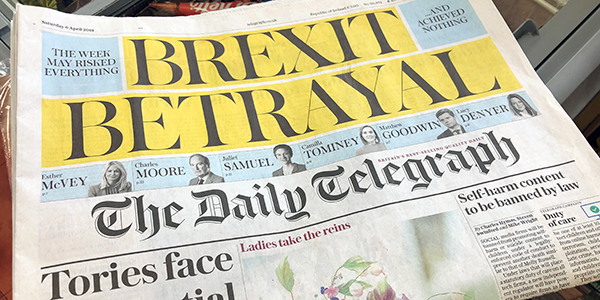
Picture: Sharon Hahn Darlin/ CC BY 2.0 licence
Plenty of research has gone into how Brexit has been playing havoc with the British party system, both in terms of party unity and discipline and public attachments to parties and voting intentions. Less attention has been paid to another set of quasi-institutional actors who are also in the business of shaping and representing public opinion – the British press. Notoriously partisan but intermittently quite capable of shifting allegiance and persuading their readers to come along, how have British newspapers been affected by the emergence of this all-engulfing new issue, which is cutting across traditional partisan divides?
It will take a much larger project to look at the supply side – to study directly and in detail how the papers have responded, reported and taken sides on the issue. However, data from the British Election Study Internet Panel (BESIP) enables us to investigate the demand side – how readers of major papers divide on the Leave/Remain issue and its more recent permutations (no-deal, the Withdrawal Agreement, Remain), and also how defections from and to papers relate to the Brexit issue and reshape the preference distributions among readerships.
Switching papers since Brexit
Defections are an important and largely neglected issue. We tend to assume that newspaper readership is more or less constant, and in fact the BESIP did not include a readership question during their first nine waves (2014–16). They instead added a readership variable from existing YouGov panel participant profiles. When the first actual readership question fielded during wave 10 (Nov/Dec 2016) allowed us to check, it became clear that the participant profiles contained outdated information for about 30% of respondents. Since then BESIP has fielded this question three more times, in the pre- and post-election waves 2017 (waves 11 and 13), and now again in their most recent wave (wave 15) fielded in March this year and just published.
Now we can trace over time the rate at which readership changes but also how such replacement alters the ideological profiles of readers of individual papers. Figure 1 reports changes in readership for the six largest papers in the BESIP sample from after the EU referendum (wave 10, Nov/Dec 2016) to the 2017 general election (wave 13, June 2017), while Figure 2 reports subsequent changes since the general election until now.
These figures tell us a number of things: rates of replacement are high across all papers, in particular for the period of Brexit negotiations since the last election. On average, almost a third of respondents no longer list the same paper as they did in 2017 as the one they read most often. Tabloids have a much less stable readership and are suffering net losses, while only the Times and Guardian seem to have attracted more new readers than they have lost old ones. (Note that these are net losses or gains within the sample – also when using sample weights – but this does not necessarily translate into lower sales or subscriptions, because it could have to do with panel attrition, or where online readers are concerned with changing perceptions of what it means to ‘read a paper most often’.)
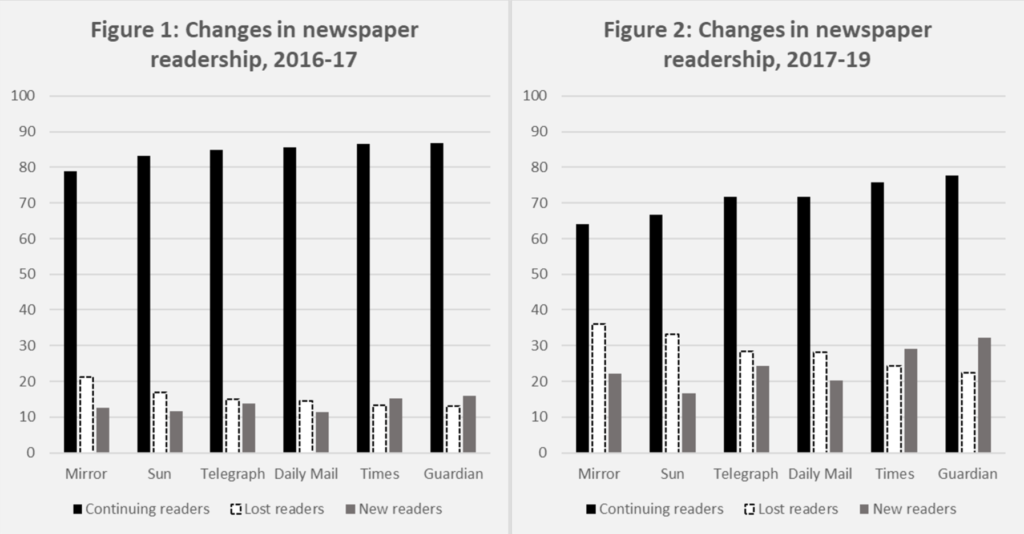
Guardian and Telegraph readers: unambiguous views
But what kind of readership, with regard to Brexit, do these papers have, and how have those readerships changed over the past couple years of Brexit negotiations? For each newspaper, we can look at these three different groups (continuing, lost and new readers) and their respective preferences when prompted to choose between no-deal and the government deal, the government deal and Remain, or no-deal and Remain.
Two newspapers stand out by having a readership that comes down most unambiguously on one side of the debate. And in each case, recent replacements have made the Brexit preferences in their readership even more skewed.
First, there is the Guardian whose readers are almost unanimously for Remain (see Figure 3).
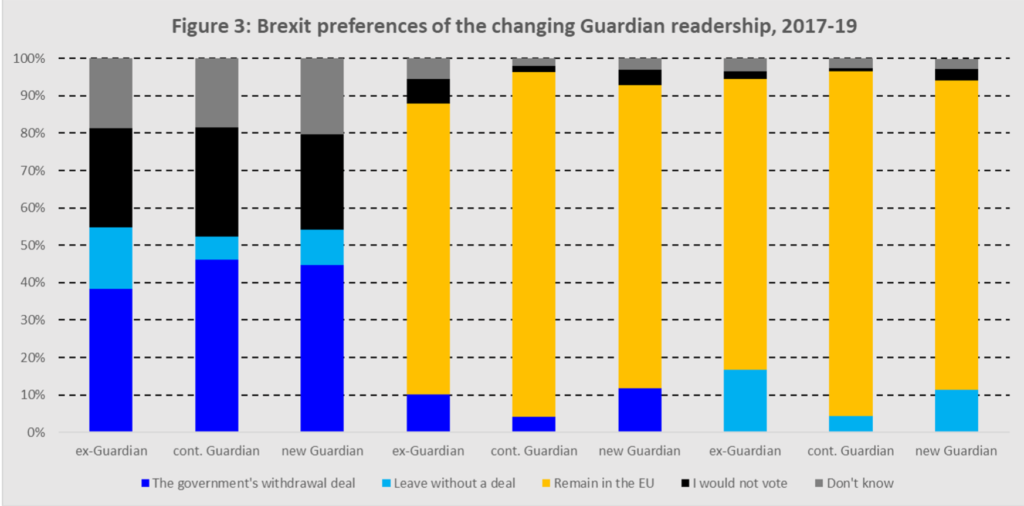
Among their long-term readers, over 90% would choose Remain, irrespective of whether the alternative were a government deal or no-deal. Almost half would either not vote or be unsure how to vote in a referendum that did not include a Remain option.
Those who have ceased to list the Guardian as their most-read paper contain slightly more Remain-sceptics as well as more undecideds. New readers are in between: not quite as enthusiastic as loyal readers, but more so than the departed ones. In that sense, the Guardian readership is becoming gradually ever more pro-Remain.
At the other end of the spectrum is the Telegraph, whose readership is not quite as extreme as the Guardian’s, but is changing more dramatically over time. Telegraph readers are predominantly Leavers, and increasingly in favour of a no-deal Brexit. Among loyal and newly recruited Telegraph readers, 60% would vote for no-deal over a government deal, over 70% for no-deal against Remain. Almost 30% of continuing and over 35% of new readers would either not vote or be unsure how to vote in a referendum that were to exclude a no-deal option.
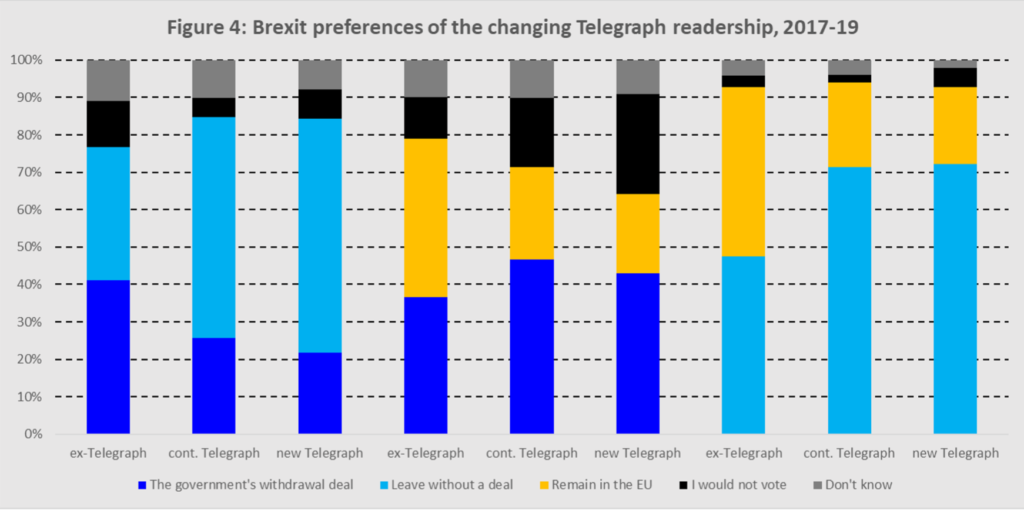
What is most dramatic about the Telegraph is how reader replacement has changed the profile of their readership. The lost readers are on average much more undecided. In each two-way race, they are equally split between the options. That means that in 2017 the Telegraph was still read by a considerable number of Remainers and soft Brexiters, who have by now gone elsewhere. It might just be the case that newspapers are much better at attracting (and repelling) readers than at persuading them.
Times readers: open to compromise
The other papers have much more varied readerships. The Times and the Mirror, basically a traditional Tory and a traditional Labour paper – both Remain but neither as outspoken or unambiguously so as the Guardian – do have on average a pro-Remain readership (Figure 5 and 6), but in case of the Times, replacement increases the number of no-dealers among their readership. The Mirror is more predominantly pro-Remain, would prefer that over both no-deal and the government deal and would in large numbers (over 40%) abstain or be undecided in a referendum that did not contain a Remain option. Times readers prefer Remain over no-deal and the government deal, but also have a clear preference for the government deal over no-deal. They are one of the groups that seems most willing to compromise, having a first preference for Remain but also a clear second preference for a particular type of Brexit. This sharply distinguishes them from the many Guardian and Mirror readers who refuse to even contemplate anything but Remain.
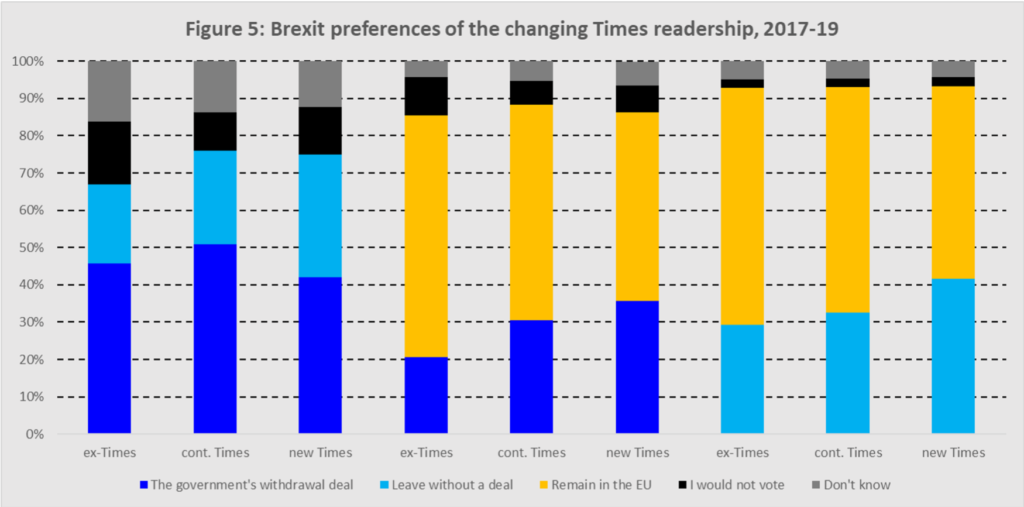
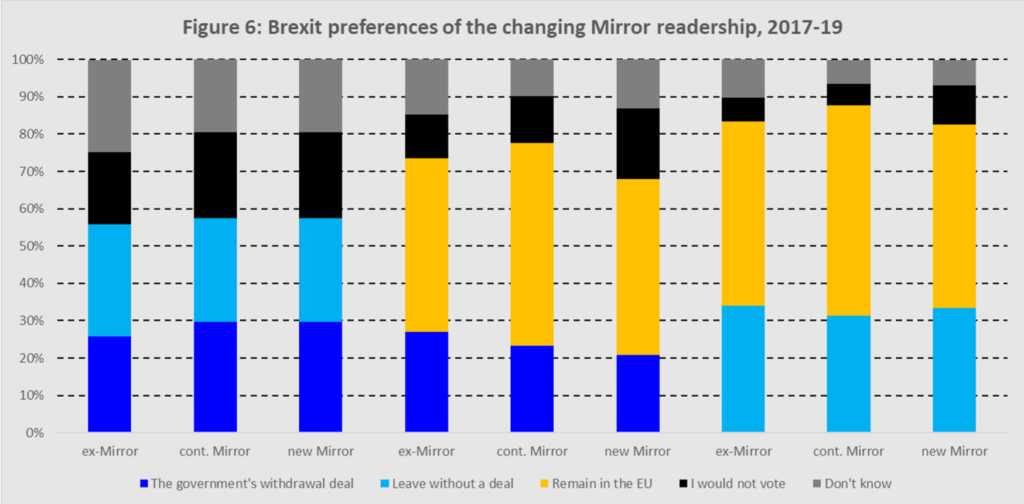
Mail readers start to turn against Johnson and Rees-Mogg
Finally, Sun and Daily Mail readers are about as strongly in the no-deal camp as Mirror and Times readers are in the Remain camp. Figure 7 and 8 look very similar. No-deal wins any two-way contest, and a referendum without a no-deal option would result in the lowest turnout among these groups.
But interestingly, in both cases, continuing readers are more extreme. Lost as well as newly recruited readers are very similar in their moderation, which means that replacement does not alter the overall distributions.
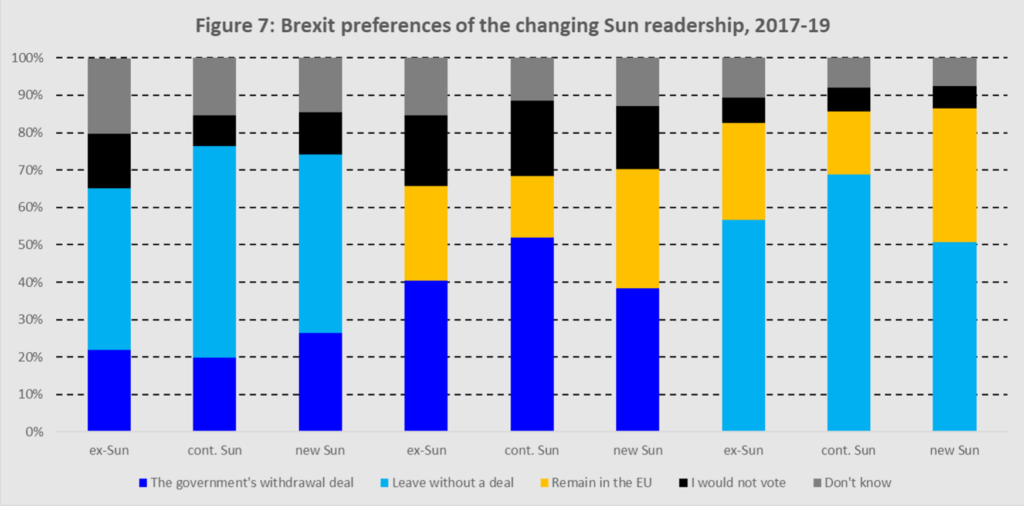
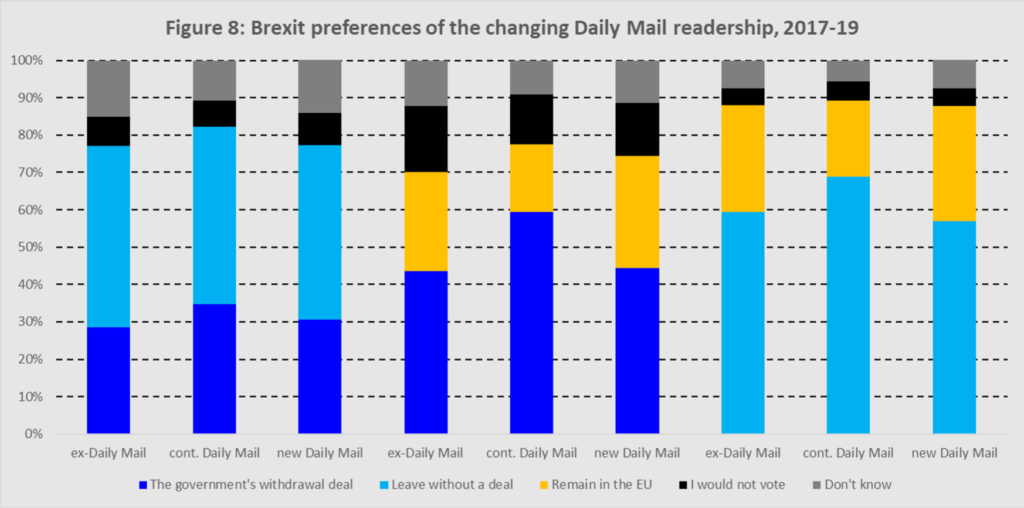
This may come as a surprise, especially when it comes to the Daily Mail. The paper famously switched position when it replaced its editor in late 2018, and reassigned the label ‘saboteur’ to the ERG rather than Tory Remainers. According to one journalist, the ‘Daily Mail turning on Hard Brexit is a cultural moment to rival Dylan going electric‘. This has not really brought more fans of the government deal on board and neither has it driven no-dealers away from the paper. But actually, looking over the preceding figures, there are more continuing Daily Mail readers supportive of Theresa May’s deal than we can find among any other group of current or ex-readers of a Leave-supporting paper – and considerably more so than among Telegraph or Sun readers. The panel data do not allow us to measure the persuasive power of the Daily Mail to bring readers around to the deal directly, because all the prior waves were well before anything like a deal was in existence. But we can tentatively assess whether opinions about key figures in favour of the deal or no-deal changed among Daily Mail readers at a different rate than among others.
Figure 9 shows how opinions about Boris Johnson, Jacob Rees-Mogg and Theresa May changed between 2018 and 2019 among different groups – loyal, new and ex-Daily Mail readers, as well as among those who say they never read the Daily Mail. Opinions about all three Tory politicians took a hit over the past year, and most strongly among long-term and continuing Daily Mail readers. The impact is strongest for Johnson and much stronger for Johnson and Rees-Mogg, the two Tories who are prepared to advocate no-deal, than for Theresa May. In fact, only among loyal Mail readers did Theresa May’s lead in popularity over her two rivals actually increase over this time period.
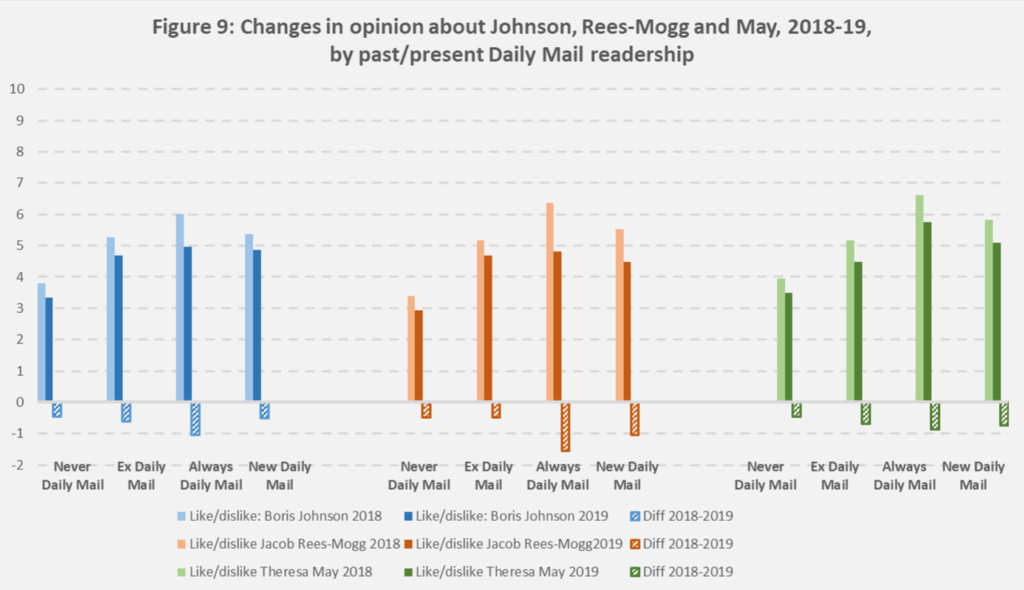
Note that these figures date from before the Tory leadership contest. Also, it would require a much more sophisticated and robust analysis to conclude that exposure to changing Mail coverage from November 2018 to May 2019 had any causal impact on such changes in attitudes towards these political figures. Even if this was an instance of media persuasion, it would still appear much less sizeable and consequential than the process by which the Telegraph engineered an increasingly homogenous readership by repelling moderates and attracting no-deal purists.
There is a certain similarity between parties and newspapers as they navigate the Brexit debate, trying to set out their stall, which creates volatility by repelling some and attracting others – where attracting is not the same as persuading. Brexit is perhaps not just upsetting the party system but also the media landscape, by loosening and sometimes even cutting ties of long-established loyalty.
This post represents the views of the author and not those of Democratic Audit. It was first published on the LSE Brexit blog.
About the author

Heinz Brandenburg is a Senior Lecturer in Politics at the University of Strathclyde.





 Democratic Audit's core funding is provided by the Joseph Rowntree Charitable Trust. Additional funding is provided by the London School of Economics.
Democratic Audit's core funding is provided by the Joseph Rowntree Charitable Trust. Additional funding is provided by the London School of Economics.
You haven’t any information about numbers of Mail subscribers who cancelled their subscriptions after Geordie Greig took over and turned its Brexit stance round 180 degrees?